Effects of Different Exhaust Gas Recirculation (EGR) Rates on Combustion and Emission Characteristics of Biodiesel–Diesel Blended Fuel Based on an Improved Chemical Mechanism
Abstract
:1. Introduction
2. Numerical Approaches
2.1. D-CFD Calculation
2.1.1. Mass Conservation Equation
2.1.2. Energy Conservation Equation
2.1.3. Ideal Gas Equation of State
2.1.4. Component Transport Equation
2.2. Spraying Model
2.3. Turbulence Model
2.4. Combustion Model
2.5. Heat Transfer Models
2.6. Emission Calculation Model
2.7. Boundary Conditions
2.8. Computational Grid
2.9. Feasibility Test
2.10. Fuel Properties
2.11. Model Validation
3. Results and Discussion
3.1. Combustion Characteristics
3.1.1. Cylinder Pressure
3.1.2. Cylinder Temperature
3.2. Performance Characteristics
3.2.1. Brake-Specific Fuel Consumption
3.2.2. Brake Thermal Efficiency
3.3. Emission Characteristics
3.3.1. NOx Emissions
3.3.2. CO Emissions
3.3.3. Soot Emissions
3.3.4. HC Emissions
4. Conclusions
- (1)
- With the increase in the EGR rate, the engine cylinder pressure and cylinder temperature decrease. This is mainly due to the increase in the EGR rate. The increased EGR increases the exhaust gas in the cylinder and reduces the oxygen concentration.
- (2)
- With the increase in the EGR rate, NOx emissions decrease. In particular, when the EGR rate is 15%, NOx emissions are reduced by 78.89%. This is because the increase in the EGR rate reduces the oxygen concentration and cylinder temperature, which inhibits the generation of NOx. Moreover, the greater the EGR rate, the more obvious the reduction in NOx.
- (3)
- However, with the increase in the EGR rate, HC, CO, and soot emissions increase. Too high an EGR rate will be unfavorable to the power performance and economy of the engine, so the EGR rate should not be too high.
Author Contributions
Funding
Institutional Review Board Statement
Informed Consent Statement
Data Availability Statement
Acknowledgments
Conflicts of Interest
Nomenclature
| BSFC | Brake-specific fuel consumption |
| BTE | Brake thermal efficiency |
| CFD | Computational fluid dynamics |
| CO | Carbon monoxide |
| CO2 | Carbon dioxide |
| EGR | Exhaust gas recirculation |
| NOx | Nitrogen oxides |
| PM | Particulate matter |
| UHC | Unburned hydrocarbon |
| hi | Specific enthalpy of inflow gas, J/kg |
| ma | Mass of the gas flowing into the cylinder, kg |
| pc | Pressure in the cylinder, Pa |
| Pre | Prandtl number in the ε equation |
| Prt | Molecular Prandtl number |
| R | Total number of reactions |
| rA | Droplet radius, m |
| t | Time, s |
| ρl | Density of the liquid, kg/m3 |
| [Xn] | Molar concentration of substance n |
| µe | Effective viscosity, Pa·s |
| Ca, C1 | Injector constants |
| cεa, cεb, Sa, Cs | Empirical constants |
| D | Mass diffusion coefficient, m2/s |
| f | Mass fraction of evaporated fuel,% |
| H | Latent heat of vaporization of the blended fuels, KJ/kg |
| ha | Specific enthalpy of outflow gas, J/kg |
| Ha | Latent heat of vaporization of the rapeseed oil, KJ/kg |
| Hb | Latent heat of vaporization of the diesel fuel, KJ/kg |
| hb | Specific enthalpy of leakage gas, J/kg |
| k | Molecular conductivity coefficient |
| mb | Mass of the gas flowing out of the cylinder, kg |
| mc | Total mass of the material in the cylinder, kg |
| me | Mass of the fuel flowing into the cylinder, kg |
| mi | Mass of the gas into the cylinder, kg |
| N | Total number of substances |
| Nm | Mass of the micro-element control body component m, kg |
| Ntt | Total mass of the micro-element control body component, kg |
| Oa | Anseger number of the droplet |
| Prk | Prandtl number in the k equation |
| qe | Latent heat of evaporation of fuel, J |
| QF | Fuel heat release, J |
| Qw | Heat loss, J |
| RA | Initial radius, m |
| Rc | Gas constant, J/(K·kg) |
| Sa | Source item |
| Sm | Generation rate of the component m per unit time kg/s |
| Ta | Fluid temperature, K |
| Tb | Wall temperature, K |
| Tc | Cylinder body temperature, K |
| TKH | Taylor number |
| us | Specific internal energy in the cylinder, J/kg |
| u | Velocity vector, m/s |
| V | Working volume, cm3 |
| Wa | Proportion of diesel in the blended fuel |
| Wb | Proportion of biodiesel in the blended fuel |
| We | Weber number of the continuous phase |
| xn | Chemical symbol of component n |
| y+ | Dimensionless distance |
| Yi | Mass fraction of m components, % |
| μτ | Shear velocity, μm/s |
| τij | Reynolds stress, Pa |
| θ | Crankshaft angle, deg |
| σ | Surface tension, dynes·cm−2 |
| τ | Oil beam presence time, s |
| Ω | Wave height index |
| Λ | Wavelength, m |
| ρ | Fluid density, kg/m3 |
References
- Tan, D.; Chen, Z.; Li, J.; Luo, J.; Yang, D.; Cui, S.; Zhang, Z. Effects of Swirl and Boiling Heat Transfer on the Performance Enhancement and Emission Reduction for a Medium Diesel Engine Fueled with Biodiesel. Processes 2021, 9, 568. [Google Scholar] [CrossRef]
- Cai, T.; Zhao, D.; Sun, Y.; Ni, S.; Li, W.; Guan, D.; Wang, B. Evaluation of NOx emissions characteristics in a CO2-Free micro-power system by implementing a perforated plate. Renew. Sustain. Energy Rev. 2021, 145, 111150. [Google Scholar] [CrossRef]
- Jiaqiang, E.; Zhang, Z.Q.; Chen, J.W.; Pham, M.; Zhao, X.H.; Peng, Q.G.; Zhang, B.; Yin, Z.B. Performance and emission evaluation of a marine diesel engine fueled by water biodiesel-diesel emulsion blends with a fuel additive of a cerium oxide nanoparticle. Energy Convers. Manag. 2018, 169, 194–205. [Google Scholar]
- Zhang, Z.; Tian, J.; Li, J.; Lv, J.; Wang, S.; Zhong, Y.; Dong, R.; Gao, S.; Cao, C.; Tan, D. Investigation on combustion, performance and emission characteristics of a diesel engine fueled with diesel/alcohol/n-butanol blended fuels. Fuel 2022, 320, 123975. [Google Scholar] [CrossRef]
- Jiaqiang, E.; Pham, M.; Zhao, D.; Deng, Y.; Duc Hieu, L.; Wei, Z.; Zhu, H.; Liu, T.; Peng, Q.; Zhang, Z. Effect of different technologies on combustion and emissions of the diesel engine fueled with biodiesel: A review. Renew. Sustain. Energy Rev. 2017, 80, 620–647. [Google Scholar]
- Cai, T.; Becker, S.M.; Cao, F.; Wang, B.; Tang, A.; Fu, J.; Han, L.; Sun, Y.; Zhao, D. NOx emission performance assessment on a perforated plate-implemented premixed ammonia-oxygen micro-combustion system. Chem. Eng. J. 2021, 417, 128033. [Google Scholar] [CrossRef]
- Öztürk, E.; Can, Ö. Effects of EGR, injection retardation and ethanol addition on combustion, performance and emissions of a DI diesel engine fueled with canola biodiesel/diesel fuel blend. Energy 2022, 244, 123129. [Google Scholar] [CrossRef]
- Fan, L.; Cheng, F.; Zhang, T.; Liu, G.; Yuan, J.; Mao, P. Visible-light photoredox-promoted desilylative allylation of α-silylamines: An efficient route to synthesis of homoallylic amines. Tetrahedron Lett. 2021, 81, 153357. [Google Scholar] [CrossRef]
- Díaz Domínguez, Y.; Rondón Macias, M.; Tabio García, D.; Melo-Espinosa, E.A.; Fernández Santana, E.; Piloto-Rodríguez, R. Influence of Moringa oleifera biodieseldiesel blend on combustion, performance and emissions in a diesel engine. Afinidad 2021, 78, 45–55. [Google Scholar]
- Zhang, Z.; Ye, J.; Tan, D.; Feng, Z.; Luo, J.; Tan, Y.; Huang, Y. The effects of Fe2O3 based DOC and SCR catalyst on the combustion and emission characteristics of a diesel engine fueled with biodiesel. Fuel 2021, 290, 120039. [Google Scholar] [CrossRef]
- Yan, Z.; Gainey, B.; Lawler, B. A parametric modeling study of thermal barrier coatings in low-temperature combustion engines. Appl. Therm. Eng. 2022, 200, 117687. [Google Scholar] [CrossRef]
- Gainey, B.; Yan, Z.; Lawler, B. Autoignition characterization of methanol, ethanol, propanol, and butanol over a wide range of operating conditions in LTC/HCCI. Fuel 2021, 287, 119495. [Google Scholar] [CrossRef]
- Reddy, E.; Keerthana, B.V.S.; Raju, V.D.; Sai, M.; Dhanush, B. Mitigation of NOx emissions with application of exhaust gas recirculation on diesel engine fuelled with diesel-corn seed oil biodiesel blend. Int. J. Ambient Energy 2020, 1–34. [Google Scholar] [CrossRef]
- Mourad, M.; Mahmoud, K.; Mohamed, S. Improving diesel engine performance and emissions characteristics fuelled with biodiesel. Fuel 2021, 302, 121097. [Google Scholar] [CrossRef]
- Cai, T.; Zhao, D. Enhancing and assessing ammonia-air combustion performance by blending with dimethyl ether. Renew. Sustain. Energy Rev. 2022, 156, 112003. [Google Scholar] [CrossRef]
- Can, Ö.; Öztürk, E.; Solmaz, H.; Aksoy, F.; ÇInar, C.; Yücesu, H. Combined effects of soybean biodiesel fuel addition and EGR application on the combustion and exhaust emissions in a diesel engine. Appl. Therm. Eng. 2015, 95, 115–124. [Google Scholar] [CrossRef]
- Shi, X.; Liu, B.; Chao, Z.; Hu, J.; Zeng, Q. A study on combined effect of high EGR rate and biodiesel on combustion and emission performance of a diesel engine. Appl. Therm. Eng. 2017, 125, 1272–1279. [Google Scholar] [CrossRef]
- Mat Yasin, M.H.; Mamat, R.; Yusop, A.; Paruka, P.; Yusaf, T.F.; Najafi, G. Effects of Exhaust Gas Recirculation (EGR) on a Diesel Engine fuelled with Palm-biodiesel. Energy Procedia 2015, 75, 30–36. [Google Scholar] [CrossRef] [Green Version]
- Zhang, Z.; Tian, J.; Xie, G.; Li, J.; Xu, W.; Jiang, F.; Huang, Y.; Tan, D. Investigation on the combustion and emission characteristics of diesel engine fueled with diesel/methanol/n-butanol blends. Fuel 2022, 314, 123088. [Google Scholar] [CrossRef]
- Zhang, Z.; Li, J.; Tian, J.; Dong, R.; Zou, Z.; Gao, S.; Tan, D. Performance, combustion and emission characteristics investigations on a diesel engine fueled with diesel/ethanol/n-butanol blends. Energy 2022, 249, 123733. [Google Scholar] [CrossRef]
- Sathyamurthy, R.; Balaji, D.; Gorjian, S.; Muthiya, S.J.; Bharathwaaj, R.; Vasanthaseelan, S.; Essa, F.A. Performance, combustion and emission characteristics of a DI-CI diesel engine fueled with corn oil methyl ester biodiesel blends. Sustain. Energy Technol. Assess. 2021, 43, 100981. [Google Scholar] [CrossRef]
- Zhang, Z.; Lv, J.; Xie, G.; Wang, S.; Ye, Y.; Huang, G.; Tan, D. Effect of assisted hydrogen on combustion and emission characteristics of a diesel engine fueled with biodiesel. Energy 2022, 254, 124269. [Google Scholar] [CrossRef]
- Boyd, Z.M.; Ramsey, S.D.; Baty, R.S. On the existence of self-similar converging shocks for arbitrary equation of state. arXiv 2017, arXiv:1707.03792. [Google Scholar]
- Beale, J.; Reitz, R. Modeling spray atomization with the Kelvin-Helmholtz/Rayleigh-Taylor hybrid model. At. Spray 1999, 9, 623–650. [Google Scholar]
- Sim, J.; Badra, J.; Elwardani, A.E.; Im, H.G. Spray Modeling for Outwardly-Opening Hollow-Cone Injector; SAE Technical Paper 2016-01-0844; SAE International: Warrendale, PA, USA, 2016. [Google Scholar]
- Koutsourakis, N.; Bartzis, J.G.; Markatos, N.C. Evaluation of Reynolds stress, k-ε and RNG k-ε turbulence models in street canyon flows using various experimental datasets. Environ. Fluid Mech. 2012, 12, 379–403. [Google Scholar] [CrossRef]
- Senecal, P.; Pomraning, E.; Richards, K.; Briggs, T.; Choi, C.; McDavid, R.; Patterson, M. Multi-Dimensional Modeling of Direct-Injection Diesel Spray Liquid Length and Flame Lift-off Length Using CFD and Parallel Detailed Chemistry; SAE Technical Paper 2003-01-1043; SAE International: Warrendale, PA, USA, 2003. [Google Scholar] [CrossRef]
- Yeckel, A.; Pandy, A.; Derby, J.J. Fixed-point convergence of modular, steady-state heat transfer models coupling multiple scales and phenomena for melt–crystal growth. Int. J. Numer. Methods Eng. 2006, 67, 1768–1789. [Google Scholar] [CrossRef]
- O’Rourke, P.J.; Amsden, A.A. A Particle Numerical Model for Wall Film Dynamics in Port-Injected Engines; SAE Technical Paper 961961; SAE International Fall Fuels and Lubricants Meeting and Exhibition; SAE International: Warrendale, PA, USA, 1996. [Google Scholar]
- Duan, J.; Yang, Z.; Sun, B.; Chen, W.; Wang, L. Study on the NOx emissions mechanism of an HICE under high load. Int. J. Hydrogen Energy 2017, 42, 22027–22035. [Google Scholar] [CrossRef]
- Heywood, J. Internal Combustion Engine Fundamentals; McGraw-Hill: New York, NY, USA, 1988. [Google Scholar]
- Yousefi, A.; Guo, H.; Birouk, M. Effect of swirl ratio on NG/diesel dual-fuel combustion at low to high engine load conditions. Appl. Energy 2018, 229, 375–388. [Google Scholar] [CrossRef]
- Jiaqiang, E.; Pham, M.; Deng, Y.; Nguyen, T.; Duy, V.; Le, D.; Zuo, W.; Peng, Q.; Zhang, Z. Effects of injection timing and injection pressure on performance and exhaust emissions of a common rail diesel engine fueled by various concentrations of fish-oil biodiesel blends. Energy 2018, 149, 979–989. [Google Scholar]
- Zhang, Z.; Li, J.; Tian, J.; Zhong, Y.; Zou, Z.; Dong, R.; Gao, S.; Xu, W.; Tan, D. The effects of Mn-based catalysts on the selective catalytic reduction of NOx with NH3 at low temperature: A review. Fuel Process. Technol. 2022, 230, 107213. [Google Scholar] [CrossRef]
- Zhang, Z.; Jiaqiang, E.; Deng, Y.; Pham, M.; Zuo, W.; Peng, Q.; Yin, Z. Effects of fatty acid methyl esters proportion on combustion and emission characteristics of a biodiesel fueled marine diesel engine. Energy Convers. Manag. 2018, 159, 244–253. [Google Scholar] [CrossRef]
- Duan, X.; Xu, Z.; Sun, X.; Deng, B.; Liu, J. Effects of injection timing and EGR on combustion and emissions characteristics of the diesel engine fuelled with acetone–butanol–ethanol/diesel blend fuels. Energy 2021, 231, 121069. [Google Scholar] [CrossRef]
- Sun, C.; Liu, Y.; Qiao, X.; Ju, D.; Tang, Q.; Fang, X.; Zhou, F. Experimental study of effects of exhaust gas recirculation on combustion, performance, and emissions of DME-biodiesel fueled engine. Energy 2020, 197, 117233. [Google Scholar] [CrossRef]
- Devarajan, Y.; Jayabal, R.K.; Ragupathy, D.; Venu, H. Emissions analysis on second generation biodiesel. Front. Environ. Sci. Eng. 2016, 11, 3. [Google Scholar] [CrossRef]
- Jiang, X.; Wei, H.; Zhou, L.; Chen, R. Numerical Study on the Effects of Multiple-Injection Coupled with EGR on Combustion and NOx Emissions in a Marine Diesel Engine. Energy Procedia 2019, 158, 4429–4434. [Google Scholar] [CrossRef]
- Liu, J.; Wang, F.; Li, S. The effects of EGR and injection timing on the engine combustion and particulate matter emission performances fueled with diesel-ethanol blends. Therm. Sci. 2018, 22, 1457–1467. [Google Scholar] [CrossRef] [Green Version]
- Labecki, L.; Ganippa, L.C. Effects of injection parameters and EGR on combustion and emission characteristics of rapeseed oil and its blends in diesel engines. Fuel 2012, 98, 15–28. [Google Scholar] [CrossRef]
- Zhang, Z.; Ye, J.; Lv, J.; Xu, W.; Tan, D.; Jiang, F.; Huang, H. Investigation on the effects of non-uniform porosity catalyst on SCR characteristic based on the field synergy analysis. J. Environ. Chem. Eng. 2022, 10, 107056. [Google Scholar] [CrossRef]
- Hu, Y.; Sun, Y.; He, J.; Fang, D.; Zhu, J.; Meng, X. Effect of friction stir processing parameters on the microstructure and properties of ZK60 magnesium alloy. Mater. Res. Express 2022, 9, 016508. [Google Scholar] [CrossRef]
- Gainey, B.; O’Donnell, P.; Yan, Z.; Moser, S.; Lawler, B. LTC performance of C1–C4 water-alcohol blends with the same cooling potential. Fuel 2021, 293, 120480. [Google Scholar] [CrossRef]
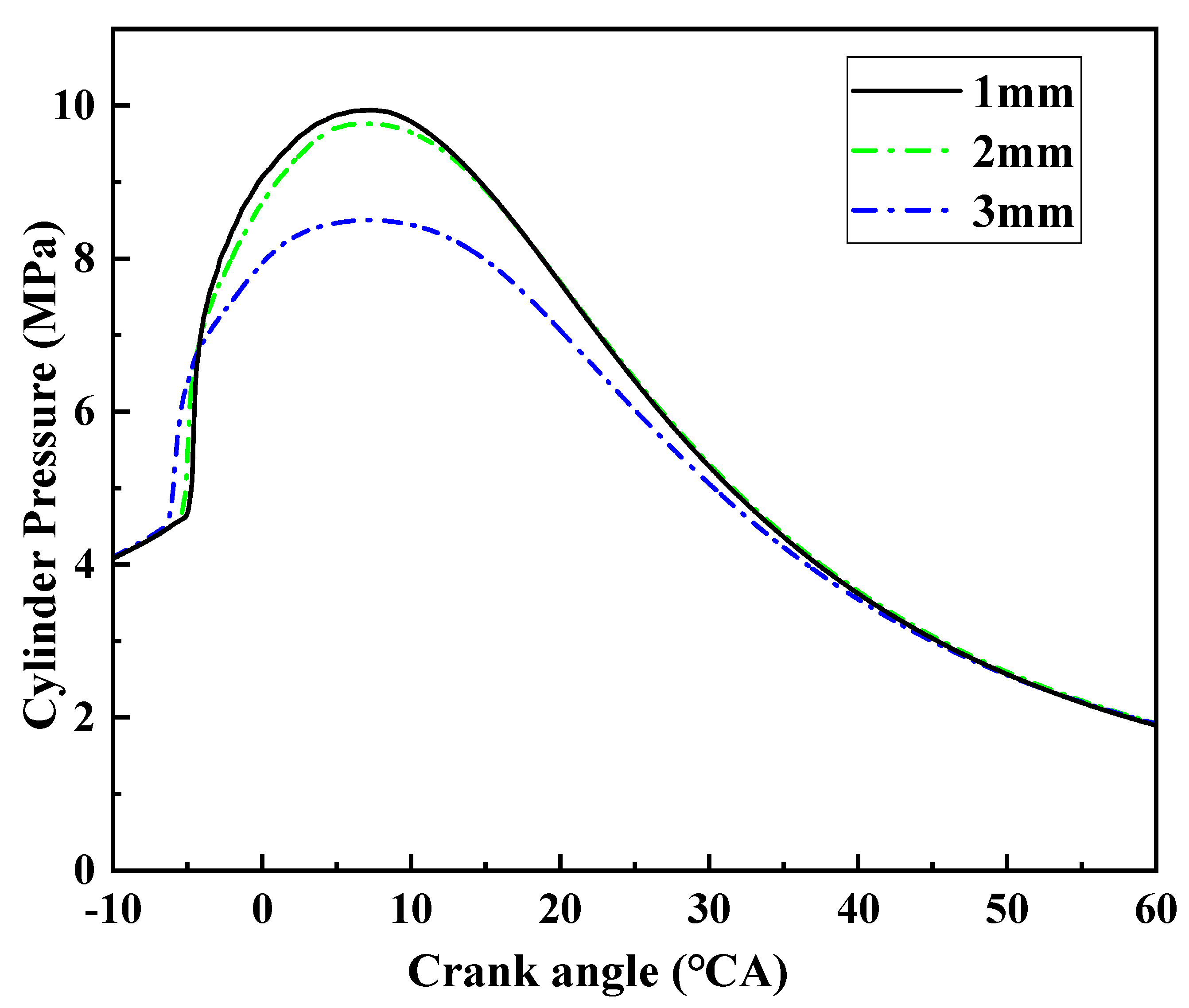


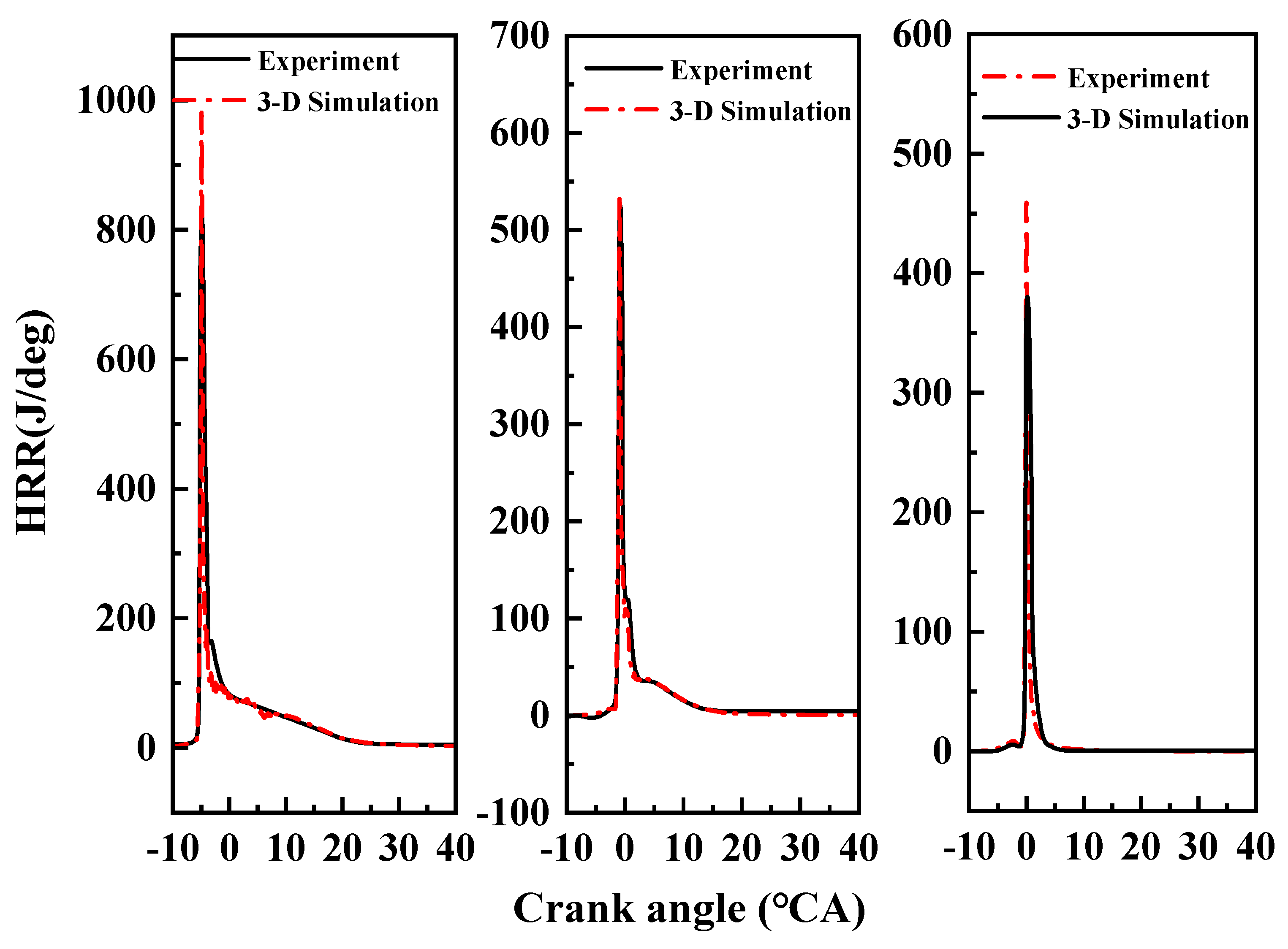






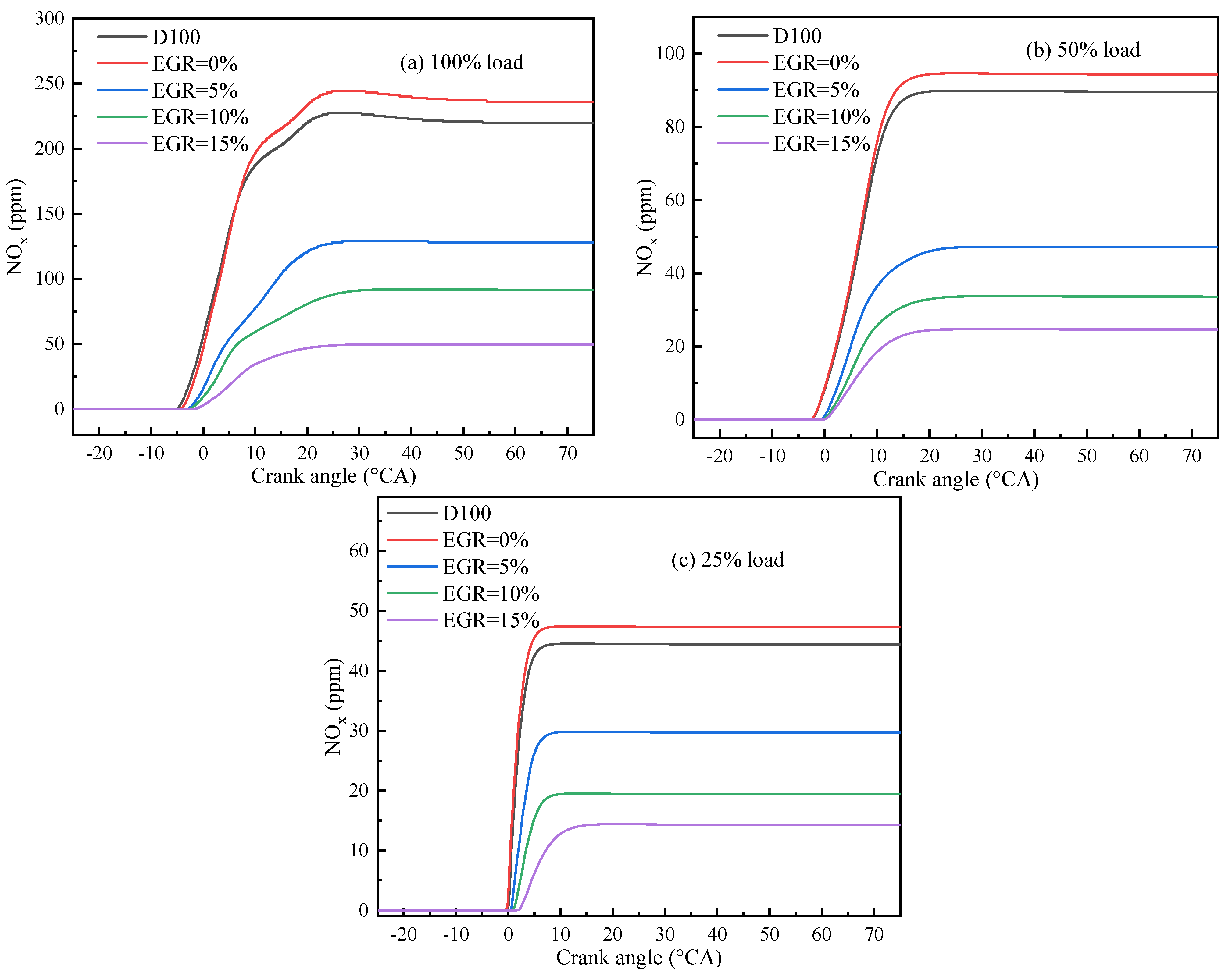


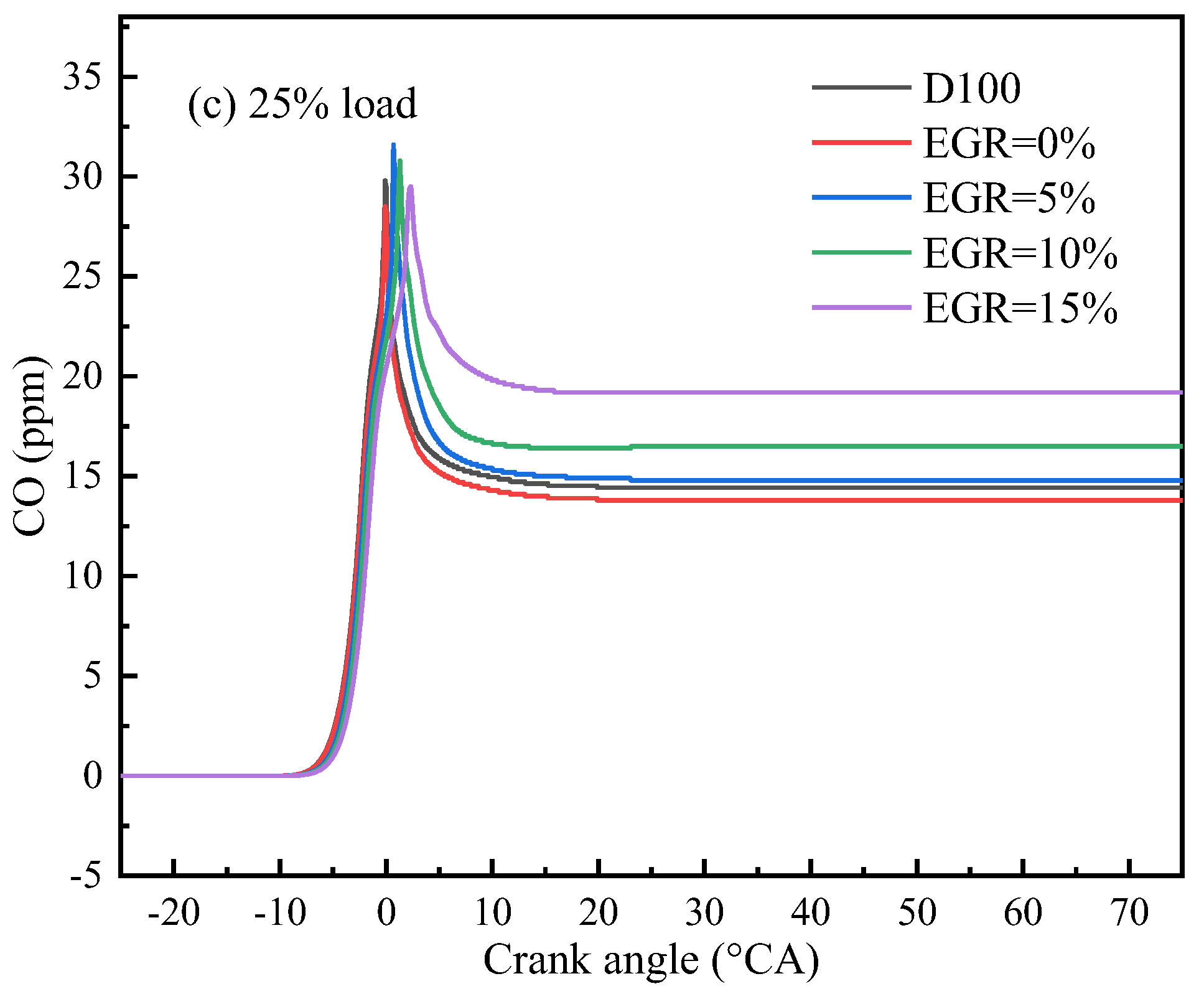


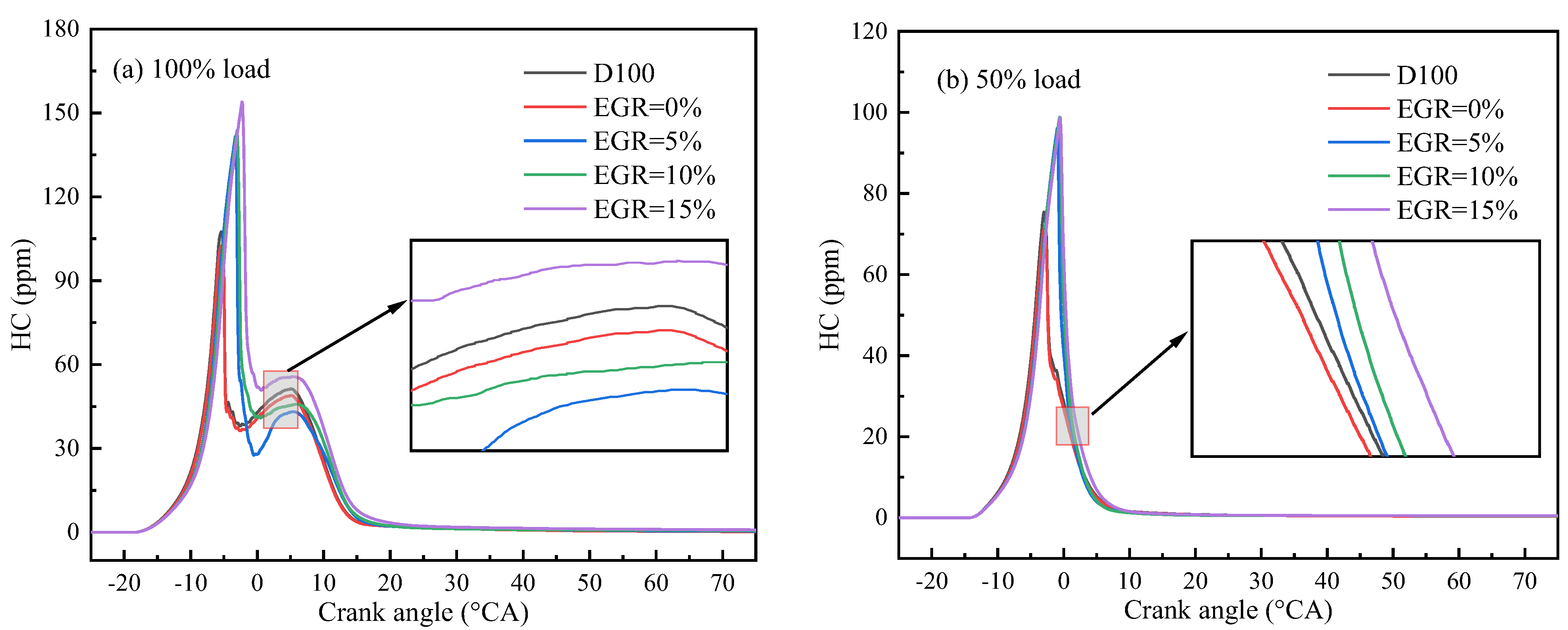

| Type | Value | Type | Value |
|---|---|---|---|
| Bore × stroke (mm) | 190 × 210 | Initial cylinder turbulentkinetic energy (m2/s2) | 18.375 |
| Connecting rod (mm) | 410 | Compression ratio | 14 |
| Rated speed (r/min) | 1000 | Initial pressure in the inlet (MPa) | 0.192 |
| Fuel injection holes | 8 | Effective power (kW) | 220 |
| Nozzle radius (mm) | 0.28 | Spray Angle (°) | 150 |
| Parameters | Measuring Range | Accuracy | Uncertainty |
|---|---|---|---|
| Pressure | 0–25 MPa | ±10 kPa | ±0.55% |
| Engine speed | 1–2000 rpm | ±40 rpm | ± 0.24% |
| Crank angle encoder | 0–720 °CA | ±0.5 °CA | ±0.30 |
| BTE | - | ±0.5% | ±1.70% |
| BSFC | - | ±5.10 g/(kW·h) | ±1.50% |
| NOx emissions | 0–6000 ppm | ±10 ppm | ±0.54% |
| CO emissions | 0–12% vol | ±0.04% | ±0.33% |
| Item | Diesel | RME |
|---|---|---|
| Cetane number (−) | 50 | 53.88 |
| Viscosity (cPs/40 °C) | 2.75 | 4.556 |
| Lower calorific value (MJ/kg) | 42.7 | 39.73 |
| Oxygen content (% m/m) | 0.3 | 10.7 |
| Density at 15 °C (kg/m3) | 837 | 882 |
| Saturation (%) | – | 4.45 |
Publisher’s Note: MDPI stays neutral with regard to jurisdictional claims in published maps and institutional affiliations. |
© 2022 by the authors. Licensee MDPI, Basel, Switzerland. This article is an open access article distributed under the terms and conditions of the Creative Commons Attribution (CC BY) license (https://creativecommons.org/licenses/by/4.0/).
Share and Cite
Huang, H.; Tian, J.; Li, J.; Tan, D. Effects of Different Exhaust Gas Recirculation (EGR) Rates on Combustion and Emission Characteristics of Biodiesel–Diesel Blended Fuel Based on an Improved Chemical Mechanism. Energies 2022, 15, 4153. https://doi.org/10.3390/en15114153
Huang H, Tian J, Li J, Tan D. Effects of Different Exhaust Gas Recirculation (EGR) Rates on Combustion and Emission Characteristics of Biodiesel–Diesel Blended Fuel Based on an Improved Chemical Mechanism. Energies. 2022; 15(11):4153. https://doi.org/10.3390/en15114153
Chicago/Turabian StyleHuang, Huiqiong, Jie Tian, Jiangtao Li, and Dongli Tan. 2022. "Effects of Different Exhaust Gas Recirculation (EGR) Rates on Combustion and Emission Characteristics of Biodiesel–Diesel Blended Fuel Based on an Improved Chemical Mechanism" Energies 15, no. 11: 4153. https://doi.org/10.3390/en15114153
APA StyleHuang, H., Tian, J., Li, J., & Tan, D. (2022). Effects of Different Exhaust Gas Recirculation (EGR) Rates on Combustion and Emission Characteristics of Biodiesel–Diesel Blended Fuel Based on an Improved Chemical Mechanism. Energies, 15(11), 4153. https://doi.org/10.3390/en15114153







